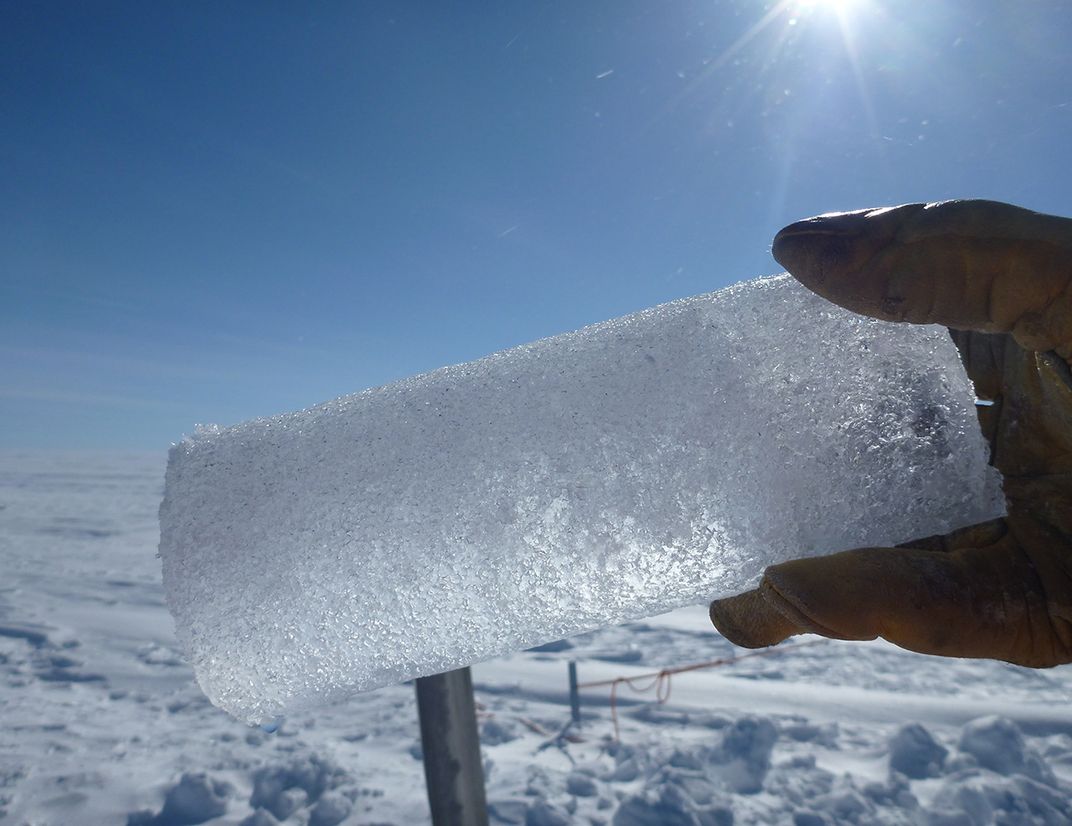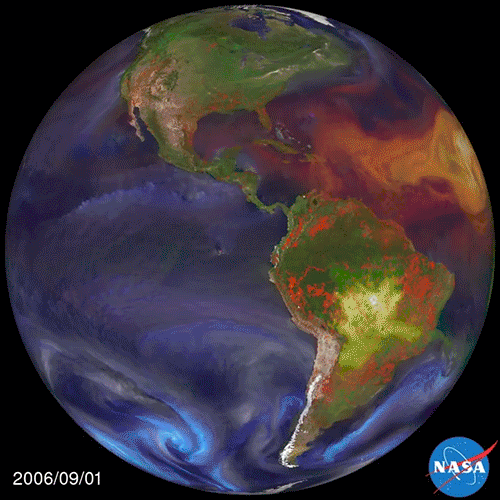Everything You Ever Wanted to Know About Earth’s Past Climates
They have a lot to tell us about our future
/https://tf-cmsv2-smithsonianmag-media.s3.amazonaws.com/filer/c4/39/c4390e00-644c-4877-9510-a64e414ef92c/aerosols.jpg)
In Silent Spring, Rachel Carson considers the Western sagebrush. “For here the natural landscape is eloquent of the interplay of forces that have created it,” she writes. “It is spread before us like the pages of an open book in which we can read why the land is what it is, and why we should preserve its integrity. But the pages lie unread.” She is lamenting the disappearance of a threatened landscape, but she may just as well be talking about markers of paleoclimate.
To know where you’re going, you have to know where you’ve been. That’s particularly true for climate scientists, who need to understand the full range of the planet’s shifts in order to chart the course of our future. But without a time machine, how do they get this kind of data?
Like Carson, they have to read the pages of the Earth. Fortunately, the Earth has kept diaries. Anything that puts down yearly layers—ocean corals, cave stalagmites, long-lived trees, tiny shelled sea creatures—faithfully records the conditions of the past. To go further, scientists dredge sediment cores and ice cores from the bottom of the ocean and the icy poles, which write their own memoirs in bursts of ash and dust and bubbles of long-trapped gas.
In a sense, then, we do have time machines: Each of these proxies tells a slightly different story, which scientists can weave together to form a more complete understanding of Earth’s past.
In March, the Smithsonian Institution’s National Museum of Natural History held a three-day Earth’s Temperature History Symposium that brought teachers, journalists, researchers and the public together to enhance their understanding of paleoclimate. During an evening lecture, Gavin Schmidt, climate modeler and director of NASA’s Goddard Institute for Space Studies, and Richard Alley, a world-famous geologist at Pennsylvania State University, explained how scientists use Earth’s past climates to improve the climate models we use to predict our future.
Here is your guide to Earth’s climate pasts—not just what we know, but how we know it.
How do we look into Earth’s past climate?
It takes a little creativity to reconstruct Earth’s past incarnations. Fortunately, scientists know the main natural factors that shape climate. They include volcanic eruptions whose ash blocks the sun, changes in Earth’s orbit that shift sunlight to different latitudes, circulation of oceans and sea ice, the layout of the continents, the size of the ozone hole, blasts of cosmic rays, and deforestation. Of these, the most important are greenhouse gases that trap the sun’s heat, particularly carbon dioxide and methane.
As Carson noted, Earth records these changes in its landscapes: in geologic layers, fossil trees, fossil shells, even crystallized rat pee—basically anything really old that gets preserved. Scientists can open up these diary pages and ask them what was going on at that time. Tree rings are particularly diligent record-keepers, recording rainfall in their annual rings; ice cores can keep exquisitely detailed accounts of seasonal conditions going back nearly a million years.

What else can an ice core tell us?
“Wow, there’s so much,” says Alley, who spent five field seasons coring ice from the Greenland ice sheet. Consider what an ice core actually is: a cross-section of layers of snowfall going back millennia.
When snow blankets the ground, it contains small air spaces filled with atmospheric gases. At the poles, older layers become buried and compressed into ice, turning these spaces into bubbles of past air, as researchers Caitlin Keating-Bitonti and Lucy Chang write in Smithsonian.com. Scientists use the chemical composition of the ice itself (the ratio of the heavy and light isotopes of oxygen in H2O) to estimate temperature. In Greenland and Antarctica, scientists like Alley extract inconceivably long ice cores—some more than two miles long!
Ice cores tell us how much snow fell during a particular year. But they also reveal dust, sea salt, ash from faraway volcanic explosions, even the pollution left by Roman plumbing. “If it’s in the air it’s in the ice,” says Alley. In the best cases, we can date ice cores to their exact season and year, counting up their annual layers like tree rings. And ice cores preserve these exquisite details going back hundreds of thousands of years, making them what Alley calls “the gold standard” of paleoclimate proxies.
Wait, but isn’t Earth’s history much longer than that?
Yes, that’s right. Paleoclimate scientists need to go back millions of years—and for that we need things even older than ice cores. Fortunately, life has a long record. The fossil record of complex life reaches back to somewhere around 600 million years. That means we have definite proxies for changes in climate going back approximately that far. One of the most important is the teeth of conodonts—extinct, eel-like creatures—which go back 520 million years.
But some of the most common climate proxies at this timescale are even more miniscule. Foraminifera (known as “forams”) and diatoms are unicellular beings that tend to live on the ocean seafloor, and are often no bigger than the period at the end of this sentence. Because they are scattered all across the Earth and have been around since the Jurassic, they’ve left a robust fossil record for scientists to probe past temperatures. Using oxygen isotopes in their shells, we can reconstruct ocean temperatures going back more than 100 million years ago.
“In every outthrust headland, in every curving beach, in every grain of sand there is a story of the earth,” Carson once wrote. Those stories, it turns out, are also hiding in the waters that created those beaches, and in creatures smaller than a grain of sand.

How much certainty do we have for deep past?
For paleoclimate scientists, life is crucial: if you have indicators of life on Earth, you can interpret temperature based on the distribution of organisms.
But when we’ve gone back so far that there are no longer even any conodont teeth, we’ve lost our main indicator. Past that we have to rely on the distribution of sediments, and markers of past glaciers, which we can extrapolate out to roughly indicate climate patterns. So the further back we go, the fewer proxies we have, and the less granular our understanding becomes. “It just gets foggier and foggier,” says Brian Huber, a Smithsonian paleobiologist who helped organize the symposium along with fellow paleobiologist research scientist and curator Scott Wing.
How does paleoclimate show us the importance of greenhouse gases?
Greenhouse gases, as their name suggests, work by trapping heat. Essentially, they end up forming an insulating blanket for the Earth. (You can get more into the basic chemistry here.) If you look at a graph of past Ice Ages, you can see that CO2 levels and Ice Ages (or global temperature) align. More CO2 equals warmer temperatures and less ice, and vice versa. “And we do know the direction of causation here,” Alley notes. “It is primarily from CO2 to (less) ice. Not the other way around.”
We can also look back at specific snapshots in time to see how Earth responds to past CO2 spikes. For instance, in a period of extreme warming during Earth’s Cenozoic era about 55.9 million years ago, enough carbon was released to about double the amount of CO2 in the atmosphere. The consequentially hot conditions wreaked havoc, causing massive migrations and extinctions; pretty much everything that lived either moved or went extinct. Plants wilted. Oceans acidified and heated up to the temperature of bathtubs.
Unfortunately, this might be a harbinger for where we’re going. “This is what’s scary to climate modelers,” says Huber. “At the rate we’re going, we’re kind of winding back time to these periods of extreme warmth.” That’s why understanding carbon dioxide’s role in past climate change helps us forecast future climate change.
That sounds pretty bad.
Yep.
I’m really impressed by how much paleoclimate data we have. But how does a climate model work?
Great question! In science, you can’t make a model unless you understand the basic principles underlying the system. So the mere fact that we’re able to make good models means that we understand how this all works. A model is essentially a simplified version of reality, based on what we know about the laws of physics and chemistry. Engineers use mathematical models to build structures that millions of people rely on, from airplanes to bridges.
Our models are based on a framework of data, much of which comes from the paleoclimate proxies scientists have collected from every corner of the world. That’s why it’s so important for data and models to be in conversation with each other. Scientists test their predictions on data from the distant past, and try to fix any discrepancies that arise. “We can go back in time and evaluate and validate the results of these models to make better predictions for what’s going to happen in the future,” says Schmidt.
Here's a model:

It's pretty. I hear the models aren’t very accurate, though.
By their very nature, models are always wrong. Think of them as an approximation, our best guess.
But ask yourself: do these guesses give us more information than we had previously? Do they provide useful predictions we wouldn’t otherwise have? Do they allow us to ask new, better questions? “As we put all of these bits together we end up with something that looks very much like the planet,” says Schmidt. “We know it’s incomplete. We know there are things that we haven’t included, we know that we’ve put in things that are a little bit wrong. But the basic patterns we see in these models are recognizable … as the patterns that we see in satellites all the time.”
So we should trust them to predict the future?
The models faithfully reproduce the patterns we see in Earth’s past, present—and in some cases, future. We are now at the point where we can compare early climate models—those of the late 1980s and 1990s that Schmidt’s team at NASA worked on—to reality. “When I was a student, the early models told us how it would warm,” says Alley. “That is happening. The models are successfully predictive as well as explanatory: they work.” Depending on where you stand, that might make you say “Oh goody! We were right!” or “Oh no! We were right.”
To check models’ accuracy, researchers go right back to the paleoclimate data that Alley and others have collected. They run models into the distant past, and compare them to the data that they actually have.
“If we can reproduce ancient past climates where we know what happened, that tells us that those models are a really good tool for us to know what’s going to happen in the future,” says Linda Ivany, a paleoclimate scientist at Syracuse University. Ivany’s research proxies are ancient clams, whose shells record not only yearly conditions but individual winters and summers going back 300 million years—making them a valuable way to check models. “The better the models get at recovering the past,” she says, “the better they’re going to be at predicting the future.”
Paleoclimate shows us that Earth’s climate has changed dramatically. Doesn’t that mean that, in a relative sense, today’s changes aren’t a big deal?
When Richard Alley tries to explain the gravity of manmade climate change, he often invokes a particular annual phenomenon: the wildfires that blaze in the hills of Los Angeles every year. These fires are predictable, cyclical, natural. But it’d be crazy to say that, since fires are the norm, it’s fine to let arsonists set fires too. Similarly, the fact that climate has changed over millions of years doesn’t mean that manmade greenhouse gases aren’t a serious global threat.
"Our civilization is predicated on stable climate and sea level," says Wing, "and everything we know from the past says that when you put a lot of carbon in the atmosphere, climate and sea level change radically."
Since the Industrial Revolution, human activities have helped warm the globe 2 degrees F, one-quarter of what Schmidt deems an “Ice Age Unit”—the temperature change that the Earth goes through between an Ice Age and a non-Ice Age. Today’s models predict another 2 to 6 degrees Celsius of warming by 2100—at least 20 times faster than past bouts of warming over the past 2 million years.
Of course there are uncertainties: “We could have a debate about whether we’re being a little too optimistic or not,” says Alley. “But not much debate about whether we’re being too scary or not.” Considering how right we were before, we should ignore history at our own peril.
/https://tf-cmsv2-smithsonianmag-media.s3.amazonaws.com/accounts/headshot/HeadshotGross_Web.jpg)
/https://tf-cmsv2-smithsonianmag-media.s3.amazonaws.com/accounts/headshot/HeadshotGross_Web.jpg)